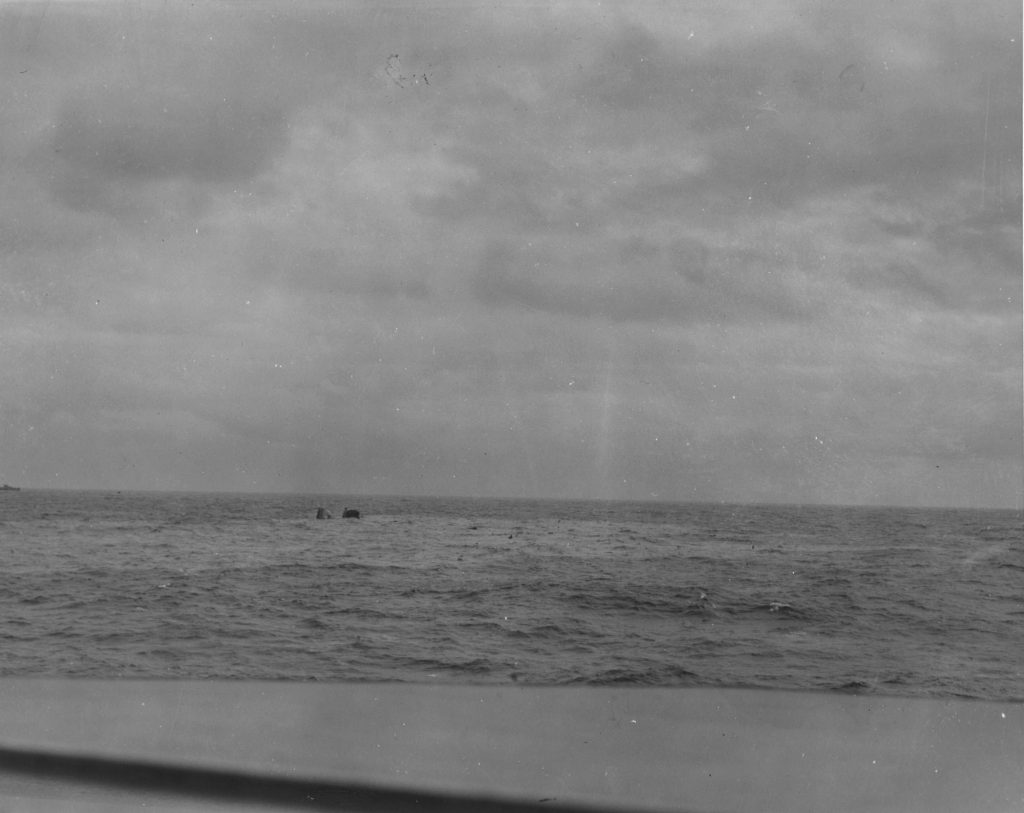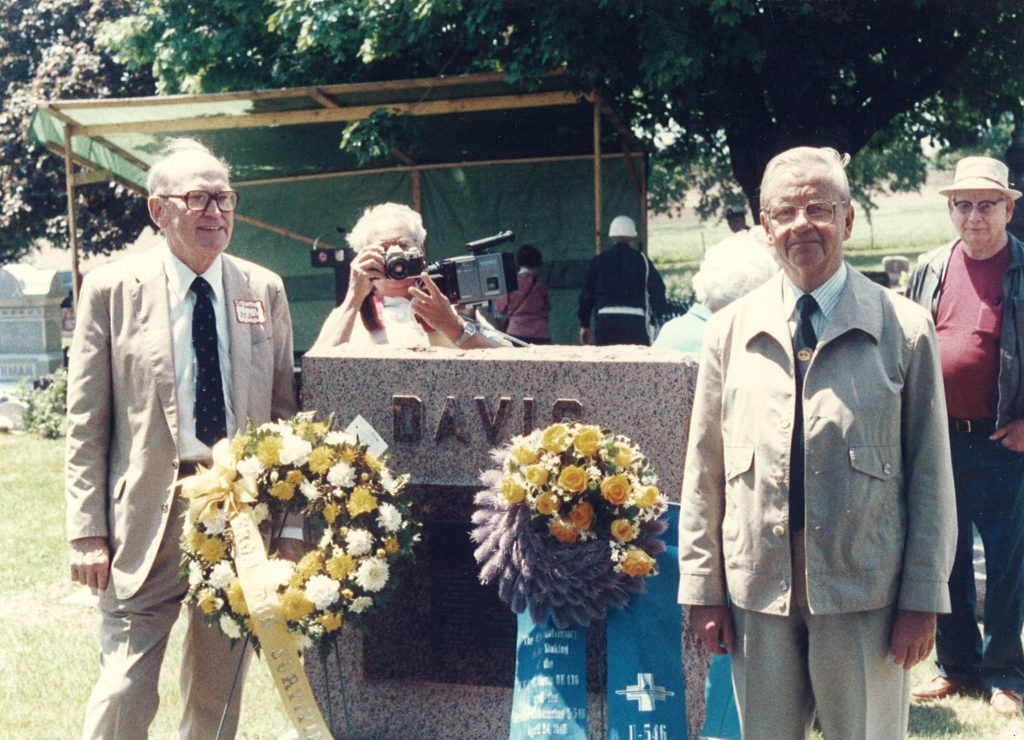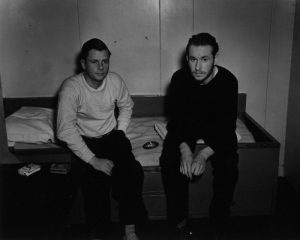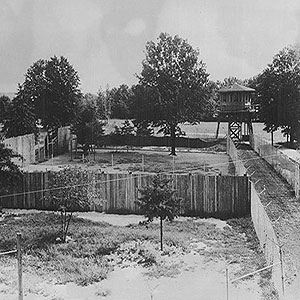Contents:
Background
Sinking and Capture
USNOB Argentia
Boston
“Fiery Furnace” at Fort Hunt
Reunion
Dr. Philip K Lundeberg
Curator Emeritus of Naval History, Smithsonian Institution
Background
On the eve of POW/MIA remembrance day, we may seek deeper understanding by beginning with a critical directive issued by the VCNO to all ships and stations on 19 May 1942 ” regarding the handling and interrogation of prisoners of war captured by vessels of the United States Navy”. This lengthy instruction, described as based on the wartime experience of the British navy, included citation of familiar provisions of the Geneva Convention and the following directive:
” (h) After being segregated and searched, prisoners shall be cared for physically; ie. given warm clothing, fed, given medical attention, cigarets, etc. Our first interest is in obtaining all information of value to us, and any humanitarian considerations must be subordinated to this interest.” 1
These rules of engagement bore directly on events shortly before V-E day involving the treatment of survivors and prisoners of war during Operation TEARDROP, the last and most far reaching barrier undertaking in the Battle of the Atlantic. Mounted by CINCLANT in late March 1945, on the basis of numerous indicators of impending V-2 missile attacks launched from U-boats against New York, TEARDROP mustered land-based air patrols from the American east coast, Newfoundland, Iceland and indeed the Azores. Those deployments, with additional RCAF patrols, were buttressed by two large surface barrier forces, based on the U.S. Naval Operating Base at Argentia in the Crown Colony of Newfoundland, thereafter positioned athwart the estimated transit route of seven schnorkel U-boats detected heading west from bases in occupied Norway. 2
Sinking and Capture

24 April 1945 – The USS Frederick C. Davis (DE-136) sinkin in the water of the North Atlantic after being hit by torpedo from the German sub U-546. Taken by a photographer of the USS Core (CVE-13) aboard the USS Neunzer (DE-150). (U.S. Navy Photo No. 323039)
Ensuing rescue operations, led by USS Hayter (DE-212), recovered 77 Davis crewmen, most in shock and hypothermia, while the hunt for U-546 continued. Few seamen would have survived had nearby U-805 (Bernardelli) ventured into the swirling ongoing action. 7 The Davis survivors, often helped on board by hardy divers, were provided showers, first aid, warm Red Cross clothing and bed rest. One groggy sailor, who had clung to his life raft for some four hours, was advised by the corpsman that his blood had begun freezing in his veins. For many it was that close. Within hours most Davis crewmen had been highlined in breeches buoys or stretchers over to the escort carrier USS Bogue (CVE-9), whose Medical Officer, Dr. James H. Pennington, led his sick bay staff and volunteers in providing urgent triage and initial repairs, in accordance with the Navy’s Handbook of First Aid Treatment of Survivors of Disasters at Sea, published in 1943. 8 Here one recalls the gallant service of British convoy rescue ships in similar circumstances, notably during the harrowing passage of Convoy ONS-5 in May 1943. 9
Meanwhile, Kaptlt. Paul Just and thirty-two crewmen from U-546 had been rescued by nearby escorts, provided showers, nourishment and warm clothing, as evident in photographs taken on board Flaherty as they enjoyed fresh air topside. 10 Within a day all had been highlined to the Bogue, where the submariners were initially berthed in the hold, away from the Davis survivors, while their Commander was briefly entertained in the wardroom. Asked about his mission, Just identified himself as deutsche offizier and declined comment, at which, in his memoire, the atmosphere became frosty. 11 Accordingly, the U-546 survivors were transferred to USS Varian (DE-798) on 25 April for swift transport to Newfoundland for interrogation. 12 En route, Just’s men received considerate treatment, in accordance with the Instructions for Interrogation of Prisoners of War, promulgated in revised edition in May 1942 to all ships and stations by the Vice Chief of Naval Operations. 13 Varian’s skipper, Lcdr. Leonard A. Myhre, welcomed Just to his cabin where they discussed mutual family matters. In accordance with the aforementioned Instructions, however, comments among the prisoners were overheard, a diary found and three survivors volunteered information on their boat’s cruise history and torpedo armament. Accordingly, Myhre prepared a detailed report for transmission of this data to Tenth Fleet. 14
USNOB Argentia
On 27 April Varian reached USNOB Argentia, Just’s crew being met by the base security detachment and hustled ashore to a Quonset but mess hall where they were identified, twenty-five being selected for further transit to prisoner-of-war cantonments in the United States. Their commander, with his First Officer, Peter Schoerieich, and six enlisted specialists were, however, taken to the base prison and lodged in solitary for the ensuing two weeks. There, by Just’s detailed account, they were subjected daily to exhausting exercises and, when unable to continue, were beaten with rubber truncheons (gummiknuppel). This treatment, which Just described as Folterung, continued, to the delight of other brig inmates, until the appearance of two interrogators from Washington on 28 April, one clad as a senior naval officer. Expressing surprise at Just’s protest about the treatment of his men, the senior interrogator (later identified as a civilian agent) requested information on the armament, mission and recent operations of U-546, as well as the names of the wolfpack’s commanding officers (already known in Washington through decrypted Enigma traffic). Upon receiving Just’s refusal, the “Captain” warned that “the Russian methods” would follow if he did not receive cooperation. 15 On 30 April, the interrogators reported to Tenth Fleet that the crew of U-546 was exceptionally security conscious, adding, however, considerable detail on the boat’s history equipage and current mission. 16 Later that day, after Just had been shown a copy of Life magazine’s shocking 16 April issue, depicting starving American soldiers found in German POW camps, he was again summoned by the senior interrogator, offered a congenial cigarette and pressed anew for information. Refusing, Just took two deep breaths from the cigarette, whereupon, he later recalled, “the room spins, the chair floats, sways, falls, my head buzzes, my ears ring and everything disappears”. Awakening later on the floor of his cell, Just was briefly visited by a priest who offered a prayer but was unable to provide assistance. The exact nature of Just’s “shock interrogation”, so described by a Tenth Fleet chronicler, remains to be established from institutional memory. 17
Details on the armament and mission of U-546 were included in the interrogators’ subsequent dispatch from Argentia to Washington later on 30 April. 18 During the ensuing week, Just and his men were subjected to daily exercises and beating, the prolonged trauma merging as a blur in his mind. Meanwhile, Varian’s commanding officer, Lcdr. Myhre, had been ashore and shared meals at the officers’ mess with the interrogators and the security force commander, who reported that the prisoners were receiving the minimum daily ration and invited him to witness the German’s exercises. As a witness, Myhre protested when Just was beaten. Surprised, the guard commander countered “You were killing them out there, weren’t you!” Those words survived and would be heard again, forty-five years later, when veterans of Flaherty, Varian and Hayter met in reunion with survivors of Davis and U-546, an occasion of truth and reconciliation long remembered. 19
Boston
Back at Argentia, for Just’s men the traumatic regimen had tapered off following the news on 8 May of Germany’s capitulation which thereby terminated their status and traditional protection as prisoners of war. Just would recall, “We are allowed to wash up, brush our teeth and comb the hair”, in evident preparation for further travel. On 10 May, three days after Germany’s capitulation, the U-546 survivors boarded a military transport and were flown under guard to Boston, there being offered a bountiful meal in a public building (“rathaus”) and lodged overnight in POW barracks at the venerable Hotel Buckminster. On 11 May the Argentia eight were featured, with an officially-sanctioned photograph, in a page one article of the Boston Evening Globe, which reported that prisoners “had been held at Argentia, Newfoundland” and that they “were on their way to Washington.” 20
Remarkably, the survivors of Frederick C. Davis had arrived at Boston that same date, somehow missing the headline story as they were processed at the South Boston Naval Annex, given medical examinations, issued new sea bags and uniforms and provided oral statements of their individual experiences before being sent_ home on survivor leave. As barebones oral history, those statements proved invaluable to theirlhi–Wdfficer survivors in preparing a final action report for the Davis and some 115 letters of condolence to families of fallen shipmates. 21
“Fiery Furnace” at Fort Hunt
Preparations had meanwhile begun in Washington on 4 May, when a meeting was held at Fort Hunt, then a secret Army-Navy interrogation center near Mount Vernon, regarding treatment to be provided the next arrivals. Landing at National Airport on 11 May, the U-546 survivors were driven in a windowless bus to Fort Hunt, there being met by guards with truncheons and lodged in solitary cells in Compound B, as specified in the Fort Hunt log. 22 During the evening all were beaten, Just recalled having been run gantlet-style down the compound corridor between gummiknuppel-wielding guards. The next day Just was again confronted by his same Argentia interrogators. Outraged by the senior officer’s bland attitude, Just demanded “What do you want of us? The war is over, why the barbarity?” In response, his interrogator indicated that a written account of the history of U-546 would suffice. That accomplished, the prolonged ordeal ended and members of the Argentia eight were gradually dispatched to POW work assignments elsewhere. 23 Records of the “Fiery Furnace” at Fort Hunt were shortly to be incinerated en masse but at least one shred of documentation survives. On 19 May a conversation between two crewmen was monitored and recorded, including the riveting statement that “POWs talk about their treatment here at the beginning and that they could not have held out much longer”. 24 Not yet discovered, if extant, would be the statement submitted by Paul Just recording the career of U-546, possibly including the grim microhistory of its survivors. Microhistorical research may thus continue long after the passing of its participants.
For perspective we turn northward to obscure events in New England. Following their brief assignment at Fort Hunt, Just’s interrogators hastened to Portsmouth, New Hampshire, where prisoners from several surrendered U-boats were being processed at the storied Portsmouth Naval Prison. Among a variety of irregularities that occurred there, subsequently investigated by the Inspector General of the Navy, was a heated three-hour interrogation of the commanding officer of surrendered U-873, Kaptlt. Friedrich Steinhoff, conducted by Paul Just’s previous interrogators. The confrontation ended abruptly when, on signal, a guard slapped the prisoner twice, sharply, whereupon Steinhoff’s defiance collapsed and he provided information. Nothing, however, was learned regarding a missile attack on New York. Subsequently moved to Boston and lodged in the Charles Street Prison, Steinhoff was reported on 19 May in the Boston Globe to have committed suicide, which thereby prompted the Portsmouth investigation, one that was not publicly disclosed. 25 In marked contrast, no such investigation would be undertaken into the covert proceedings at Argentia and Fort Hunt. Long unappreciated, therefore, remains the cautionary fact that, in contrast to a Boston suicide, hardy survivors at sea would endure prolonged duress, appreciating the veritable gift of new life and ultimately achieving catharsis through a final reckoning with history.
Reunion

Dr. Philip K Lundeberg poses for a photograph with Kapitänleutnant Paul Just at the Frederick C. Davis survivors’ organization held their annual reunion in Janesville, Wisconsin on Memorial Day, 1990.
(Return to April 2016 Table of Contents)
Footnotes
- VCNO directive to all ships and stations, Instructions for Interrogation of Prisoners of War, dated 19 May 1942, contained in Inspector General of the Navy message to COMINCH/CNO on 19 June 1945 regarding “Irregularities Connected with the Handling of Surrendered German Submarines and Prisoners of War at the Navy Yard, Portsmouth, New Hampshire.” ↩
- Philip K Lundeberg, “Operation TEARDROP Revisited,” in Timothy Runyan and Jan Copes, eds., To Die Gallantly: The Battle of the Atlantic. Boulder, Oxford, Westview Press, 1994, pp. 210-230. ↩
- Gunther Hessler, German Naval History: The U-Boat war in the Atlantic. 1939-1945. London, Ministry of Defence, 1983. section 3, p.97. ↩
- Lundeberg, “TEARDROP”, pp. 221-222; Paul Just, Vom Seeflieger Zum U-Boot-Fahrer. Stuttgart, Motorbuch Verlag, 1979 pp. 162-164. ↩
- Ibid.; Lundeberg, “TEARDROP”, pp. 221-222; USS Flaherty (DE-135) Deck Log, 24-25 April 1945. ↩
- Ibid.; Philip K Lundeberg, American Anti-Submarine Operations in the Atlantic, May 1943-May 1945. Ann Arbor, University Microfilms, 1997, pp. 430-436. ↩
- Ibid.; U-805, Kriegstagebuch, 24 April 1945, in MSS Division, Library of Congress. ↩
- Handbook of First Aid Treatment for Survivors of Disasters at Sea, Washington, 1943; Medical Officer, USS Bogue, Extent of Injuries of Surviviors of the USS Frederick C. Davis, 27 April 1945; personal communication from Seaman A. Raymond Adcock. 1999. ↩
- Note the service provided by H.M. Rescue Trawlers Northern Gem and Northern Spray in the passage of ONS-5. Lundeberg, American Anti-Submarine Operations, pp. 36-39; Surgeon Lieutenant R.D. Wilkins, RNVR, “Convoy Rescue Ships”, in Journal of the Royal Naval Medical Service, April 1944, pp. 65-69. ↩
- USS Flaherty, Deck Log, 24-25 April 1945; telephone conversation with Captain Howard C. Duff, 4 August 1993; letter with photographs from Harry J. Briscoe, 15 May 2000. ↩
- USS Bogue, Deck Log, 25-26 April 1945; Just, U-Boot-Fahrer, pp. 179-182. ↩
- Cinclant message to CTU 22.7.1 of 25 April 1945. ↩
- VCNO directive 19 May 1942, contained in Inspector General of the Navy message to COMINCH/CNO on 19 June 1945 regarding ” Irregularities Connected with the Handling of Surrendered German Submarines and Prisoners of War at the Navy Yard, Portsmouth, New Hampshire”. ↩
- Commanding Officer, USS Varian, report on ” Information from Prisoners of War from U-546 taken aboard the USS Varian ( DE-798) 24 April 1945″. ↩
- Cf. account in Just, U-Boot-Fahrer, pp. 192-204, with statement in letter of 7 July 1945 from Head, Special Activities branch, OK to Captain E.S. Brand, RCN, Director of Naval Intelligence and Trade, Ottawa, as follows: ” Due to the arrival of the Captured U-Boats at Portsmouth it was necessary to send the crew of U-546 to their final camp in order to make room for the incoming prisoners and passengers from the five captured U-Boats. It was impossible, therefore, to carry out a detailed interrogation of U546.” The letter bears the inscription ” Original delivered by hand, 7 July 1945 ” signed by the junior interrogator involved at Argentia and Fort Hunt. ↩
- NOB Argentia message of 300015 April to CNO Tenth Fleet: Wyman H. Packard, A Century of U.S. Naval Intelligence. Washington, Department of the Navy, 1996. pp.124-129. ↩
- Just, U-Boot-Fahrer, pp. 202-203; Ladislas Farago, The Tenth Fleet. New York, Ivan Obolensky, 1962, pp. 20-21; Life magazine, 16 April 1945. ↩
- NOB Argentia message of 301217 April to CNO Tenth Fleet. ↩
- Interview with Leonard A Myhre, former C.O. Varian, at Davis reunion, Janesville WI, Memorial day weekend, May 1990; Hayter Highlights newsletter June 1990. ↩
- Just, U-Boot-Fahrer, pp. 204-210; Boston Evening Globe, 11 May 1945. ↩
- Ens. Robert E. Minerd, Senior Surviving Officer, USS Frederick C. Davis, Action Report to COMCINCH, Torpedoing of the USS Frederick C. Davis on the 24th April 1945; condolence letter copies in the Operational Archives, Naval Heritage and History Center, Washington Navy Yard. ↩
- Special Activities Branch (Op-16Z) Office of Naval Intelligence, Fort Hunt Log, 4-5 May 1945. ↩
- Ibid., 11-12 May 1945; Just, U-Boot-Fahrer, pp. 212-216. ↩
- Report on monitored conversation between POWs Georg Mueller and Johannes Benn in room B13 on 19 May 1945 at Fort Hunt interrogation compound B, found in National Archives RG 165, Ft Hunt German POW 201 files. ↩
- Boston Globe, 19 May 1945, quoting Associated Press on the Steinhoff suicide, which led to the aforementioned Portsmouth investigation. ↩
- For perspective on opposing sides of the interrogation table, see Lundeberg, “Teardrop”, pp.222- 225; Joseph G. Brennan, Foundations of Moral Obligation: The Stockdale Course. Newport, Naval War College Press, 1992; and National Defence University, Moral Obligation and the Military. NDU Press, Washington, 1998. ↩



Pingback: On Naval Strategy, Part 16 | In The Corner, Mumbling and Drooling